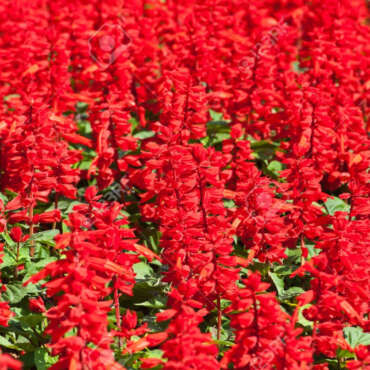Product Description
Salvia – Flats (36)
SALVIA BASICS
Zones:
Most varieties can be used as perennials in zones 5-9, with some varieties cold hardy to zone 4 or heat tolerant to zone 10.
Height/Spread:
Varieties 1 to 6 feet tall & wide, with most averaging 2 to 3 feet.
Exposure:
Full sun, 6 hours of sunlight a day is needed to promote flowering. There are varieties that will also tolerate partial shade. (See more full-sun perennials.)
Bloom Time:
As a rule, salvias bloom late spring to fall, with some starting a little earlier and others like S. leucantha blooming later.
Colors and characteristics:
Flower spikes bloom in shades of blue, dark purple, lavender, red, pink, white and a rare yellow. The stems are square and have narrow, velvety green leaves.
Is salvia a perennial?
Some salvias are considered annuals and others perennials. Among the perennials, there are old-world types that come from Europe and Asia, as well as American natives that come from the western half of the U.S. In addition, some salvias are classified as woody-stemmed shrubs, some are deciduous plants that die to the ground during winter, and others are evergreen.
Is salvia poisonous?
Salvia is not poisonous to dogs, cats, or horses; however, if ingested in large quantities it can cause temporary stomach upset.
Is salvia deer resistant?
Deer tend to steer clear from salvias and other sages, as they don’t like plants with a strong scent.
HOW TO PLANT SALVIA
When to plant:
Potted salvias can be purchased and planted in spring or fall. (Learn more about the benefits of fall planting). Seeds should be started indoors 6 to 8 weeks before last frost date, and seedlings put out after all threat of frost has passed.
Where to plant:
Picking the right spot for your salvia can make a difference in how well the plant grows and flowers. Most salvias will be happiest in a sunny spot with good drainage. Use them along your home’s foundation or as part of mixed perennial borders. They can also be grown in containers. Salvias are especially nice for growing along paths because of the way they spill over and soften the edges.
Soil:
Salvia plants don’t need rich soil, but they must have good drainage. If your soil is heavy, plant “proud”, or slightly higher than the surrounding grade. In pots, a mixture of ordinary garden soil mixed with perlite allows water to drain rapidly. Whether in the garden or in a pot, a mulch of wood chips or small, rough-edged rock is highly recommended to not only protect the roots, but to help keep the soil temperature and moisture consistent.
Spacing:
Salvias don’t like to be crowded. When planting in groups or amongst other plants, determine the spacing based on their mature size. Space them far enough apart to ensure good air circulation.
SALVIA CARE
Water:
Most varieties of salvia are drought tolerant once established, but they’ll look better with occasional water.
Pruning:
Deadheading is important to encourage repeat blooming. However, if you are looking to harvest seed, leave a few flowerheads to dry naturally on the plant. Collect the seedpods and shake out into a bag or jar.
Fertilizer:
Most salvias are light feeders and only occasionally need fertilizer. A light application of a balanced fertilizer or compost in early spring can be sufficient.
Diseases and pests:
No serious disease or pest problems affect salvia plants.
Flopping:
There are a variety of reasons salvias flop, including too much water, from rain or irrigation, not enough sun, or too much fertilizer. If your salvia plant has become leggy and flopped over you can either provide support for the plant with stakes or deadhead the flowers and let new ones grow in. Many gardeners think flopping is a sign that it is time to prune or divide their salvia.
Specifications
- Weight: 15 lb
- >>: Colors are approximate

